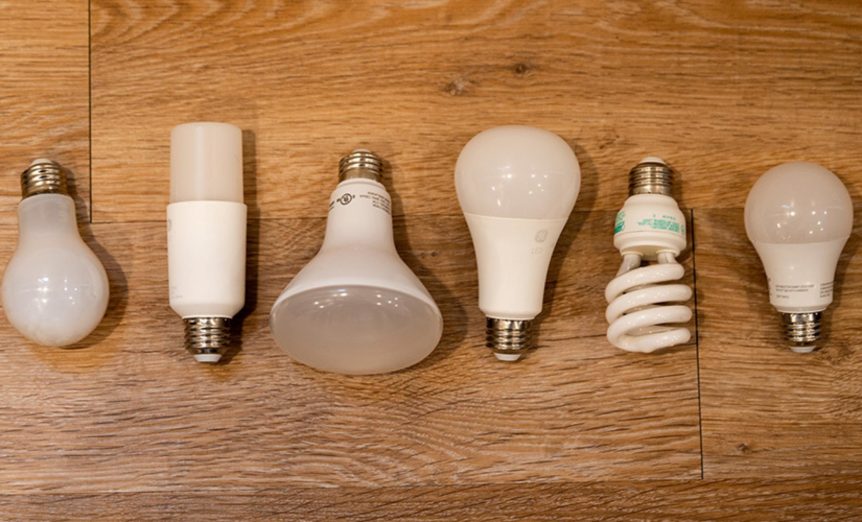Now that we are all following the new stay-at-home orders, we may start noticing new things in our home, like the lighting or lack of. Is your home feeling dark and drab? Many of us don’t give much thought to home lighting, but choosing the right light bulbs for your home can enhance the atmosphere, save money on your electric bills, and even increase your productivity. Knowing how to choose light bulbs that work best in a given space can be challenging if you are unsure of your options.
Light Bulb Performance
Light bulb brightness and color can alter the appearance of the room and even impact your mood while you’re in the space. Therefore, it’s not a good idea to buy a whole case of the same light bulb and install them throughout your house. Here are a few things to consider when purchasing light bulbs for each area of your home.
- Brightness
Light brightness is measured in lumens, and the amount of energy it takes to produce a given lumen level is measured in watts. Standard incandescent bulbs commonly range from 40 watt bulbs, which produce 450 lumens, to 100 watt bulbs, which produce 1,600 lumens. In rooms that require higher light levels like kitchens or home offices, choose light bulbs with higher lumen levels. Low light spaces, like hallways or closets, may only need bulbs with an output of 450 to 800 lumens. - Temperature
Today’s light bulb labels refer to “color temperature,” which is measured in Kelvins. Lower temperatures indicate warmer tones. A light color measurement of 2700K to 3000K is comparable to the warm yellow or white tones of incandescent light bulbs, while a 4000K bulb emits a pure, white light. The best light bulbs for natural light are 5000K bulbs, which emit a cool tone that simulates daylight. - Color Rendering Index
Another measurement, often used with CFL bulbs, is the color rendering index (CRI.) The CRI refers to how an object’s color appears under the bulb’s light, when compared to how its coloring appears under ideal or natural lighting. A higher value indicates a more true representation of color. Incandescent bulbs typically have a CRI value of 100, which is the highest possible value. Florescent lighting usually ranges between 50 and 98, and LEDs fall between 80 to 98. A CRI value of 80 or higher is ideal, but you may want to consider higher values for spaces where a true rendition of coloring matters – bathroom vanity areas or home art studios, for example.
Types of Light Bulbs
There are three main types of bulbs on the market today to consider when choosing the right light bulbs: halogen incandescent bulbs, compact florescent bulbs, and LEDs. Light quality is now fairly standard across all three types, but cost and energy efficiency vary considerably.
- Incandescent bulbs have been around for more than a century and were the main choice for home lighting for most of the 20th century. Today’s halogen incandescent bulbs come in a variety of shapes and colors. They emit a warm, ambient light that flatters skin tones. Although they are not energy-efficient – less than 10 percent of the energy they consume is converted to visible light – they are the least expensive option. Since of lot of the energy they take in is converted to heat, they can be hot to the touch.
- Compact florescent light bulbs (CFLs) operate just like those long fluorescent tube lights you see in classrooms and stores, but they are compactly coiled to work in traditional light fixtures. Energy Star-rated CFLs use roughly one-third the energy of halogen incandescent bulbs while still giving out the same level of light, and they last up to 8-10 times longer. CFLs produce heat, and their lifespan may be reduced when placed in glass or globe fixtures due to limited ventilation. Their lifespan is also shortened when they are turned on and off frequently, and you may notice flickering or a slight lag each time they are turned on.
CFLs have a reputation of giving off harsh light, but newer versions are available in cool or warm (white to yellow) tones. CFLs may not work with traditional dimmer switches, so be sure to check the packaging for compatibility. One caution: florescent bulbs contain small amounts of mercury, causing a hazard if they break. Proper disposal or recycling of CFL bulbs is critical. (Check here for recycling options.)
- LED bulbs (light emitting diode) are the newest light bulbs to hit the market. They are the most costly, but they are also the most energy efficient. An LED bulb emits little to no heat and uses just 6-8 watts of energy to produce the same brightness as a standard 60 watt incandescent bulb. They last about six times longer than CFLs and over 30 times longer than incandescent bulbs. While incandescent bulbs and CFLs emit light in all directions, LEDs are directional. To counteract this feature, LEDs light bulbs have a special coating to diffuse light, but lower quality bulbs may seem dimmer than their counterparts.
Paul’s Electric recommends upgrading to LED lights – and then watch your savings grow!
Light Bulb Recommendations Throughout Your Home
Choosing the best light bulbs for your home requires room-by-room evaluation. Consider your home’s unique needs when selecting bulbs and light fixtures. To save energy, use LED bulbs in places where lights are left on for long periods of time. Use these tips as a guide:
- Kitchens
Typically, you’ll want brighter light (5,000 to 10,000 lumens total) in task-oriented rooms like kitchens. Overhead or recessed fixtures with LEDs are a good choice, and under-cabinet lights can make a huge difference in food preparation areas. - Bathrooms
Moderate to bright general lighting, with additional task lighting near the bathroom vanity is a good choice. Remember to choose a bulb with a high CRI. A halogen incandescent that doubles as a heat lamp is one option that can help you avoid post-shower shivers. Another tip: avoid CFLs in the bathroom. These lights are frequently turned on and off, which causes CFLs to burn out more quickly than normal. - Living Rooms/Dining Rooms
Low to moderate lighting levels are typical for these spaces. A ceiling fan with light kit may work well. Choose bulbs with color temperatures of around 2,000K to 3,000K for warm, soft lighting. Add desk lamps for additional reading light, if needed. For an elegant look, install pendant lights or a chandelier above the dining room table. - Bedrooms
Low to moderate lighting levels work well in bedrooms, too. Avoid bulbs with cool tones. Exposure to their bluish light before bedtime may make it harder to fall asleep. - Home Offices
Install bright general lighting, with targeted task lighting for workspaces. Cool tones with a color temperature of 4000K or higher can help keep you alert and focused.
Let the Experts at Paul’s Electric help with your home lighting needs
Even if you know how to choose the right light bulbs, upgrading your lighting may not be something you want to do on your own. There are so many decisions beyond bulbs – from choosing distinctive lighting fixtures to deciding where to install dimmer switches. Don’t let your motivation dim! Paul’s Electric specializes in lighting design and installations. Call us at (801) 367-1464 to learn more or contact us here.

